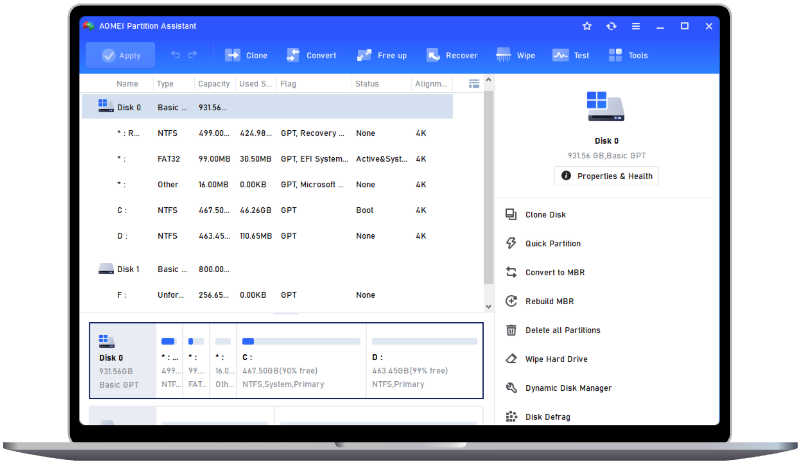8 Ways to Fix the Unable to Load Portable Drive Issue
If you are unable to load portable drive in Windows, you come to the right place. This article offers eight methods to fix this issue easily and quickly.
Why is unable to load portable drive?
If you're unable to load a portable drive, it could be due to a number of reasons including a faulty USB cable, a problematic USB port on your computer, a damaged drive, outdated drivers, or even a corrupted file system on the portable drive itself; check the physical connection, try a different USB port, inspect the cable for damage, and if necessary, use disk management tools to check the drive's health and potentially repair errors; if the issue persists, consider backing up important data and potentially formatting the drive (which will erase all data) to try to resolve the problem.
Potential causes:
✲ Faulty USB cable: The cable connecting the drive to your computer might be damaged or worn out.
✲ Bad USB port: The USB port on your computer could be faulty or not providing enough power.
✲ Drive malfunction: The portable drive itself could be physically damaged or failing.
✲ Outdated drivers: Your computer might need updated drivers for USB devices.
✲ File system errors: The drive's file system may be corrupted due to unexpected shutdowns or virus infections.
✲ Incorrect partition settings: The drive might not have a properly formatted partition.
✲ Power issues: Some external drives might require external power, which could be causing the problem if not properly connected.
How to fix the unable to load portable drive issue
In this part, we’ll go through both quick troubleshooting fixes and more advanced solutions to get your portable drive working again.
✎ Quick troubleshooting fixes
Before diving into advanced solutions, it's worth trying some quick fixes. These can help you rule out simple issues and may solve theunable to load portable drive Windows 10 problem right away.
Fix 1. Check connections
The first step is to ensure that your portable drive is securely connected to your computer. Sometimes, the issue is as simple as a loose connection. Disconnect the drive, wait a few seconds, and reconnect it carefully. Also, check that the drive is properly powered (if required) and that no loose cables are involved.
Fix 2. Check the USB port and cable
Faulty cables or USB ports are often the culprits behind issues with loading portable drives. Try using a different USB port on your computer to see if the problem persists. If you have a spare USB cable, swap it out and check if the drive loads. In some cases, the USB port or cable may be damaged, preventing the drive from being detected properly.
Fix 3. Restart your computer
Sometimes, all it takes is a simple restart. Reboot your computer to refresh the system and its connection to the portable drive. This can help resolve USB portable drive not recognized issues caused by temporary system glitches or conflicts between software and hardware.
Fix 4. Test the drive on another computer
If the drive still isn’t loading, try plugging it into another computer. This will help determine whether the issue is with the drive itself or your computer’s settings. If the drive works on another system, the problem likely lies within your computer's hardware or software configuration.
✎ Advanced solutions
If the quick fixes haven’t resolved the issue, it’s time to dive deeper into troubleshooting. Here are some advanced solutions that may help fix the portable hard drive won't open problem.
Solution 1. Change drive letter
Sometimes, the issue may arise because the portable drive is assigned a conflicting drive letter or no letter at all. To fix this:
Step 1. Right-click on the Start menu and select Disk Management.
Step 2. Find your portable drive in the list of volumes.
Step 3. Right-click on the drive and choose Change Drive Letter and Paths.
Step 4. Click Change, select a new drive letter, and then click OK.
Solution 2. Update or reinstall drivers
Outdated or corrupt drivers can prevent your portable drive from loading. Here’s how to update or reinstall your drivers:
Step 1. Right-click on the Start menu and select Device Manager.
Step 2. Expand the Disk Drives section.
Step 3. Right-click on your portable drive and select Update Driver.
Step 4. Follow the on-screen instructions to update the driver automatically.
Step 5. If updating doesn’t work, you can also try uninstalling the driver and restarting your computer, which will prompt Windows to reinstall the driver.
Solution 3. Check for file system issues
Corrupt file systems can cause your portable drive not showing up. To check for file system issues:
Step 1. Press Win + X and select Command Prompt (Admin).
Step 2. Type chkdsk C: /f /r (replace "C" with your drive letter) and press Enter.
Step 3. Wait for the scan to complete and fix any issues automatically.
Solution 4. Format the drive (last resort)
If all else fails and the drive still won’t load, formatting it may be your last resort. Formatting will erase all the data on the drive, so make sure to back up any important files before proceeding.
Step 1. Open Disk Management (right-click the Start menu and select it).
Step 2. Right-click the portable drive and select Format.
Step 3. Choose the file system (usually NTFS or exFAT), and click OK.
However, Disk Management may not always be effective for formatting hard drives in some scenarios like the hard drive is RAW or write-protected. So, what should you do when you encounter this issue? Is there an alternative to Disk Management? Fortunately, there is a much better free solution – AOMEI Partition Assistant. This powerful tool offers several key advantages over Disk Management:
◈ Format hard drives to NTFS, FAT32, Ext2, Ext3, Ext4, or exFAT.
◈ Format partitions larger than 32GB into the FAT32 file system.
◈ Successfully format RAW and write-protected hard drives.
◈ Format the C drive with the help of bootable media.
◈ Convert between FAT32 and NTFS without reformatting the drive.
If you’re unable to format a hard drive using Disk Management, consider using this robust software as an alternative.
Step 1. Install and launch AOMEI Partition Assistant. Right-click the USB drive and select “Format Partition”.
Step 2. Choose the NTFS under the “File System” drop-down menu, and click on “OK”.
Step 3. Click on “Apply” and “Proceed” to commit the pending operation.
Conclusion
In conclusion, if you are unable to load portable drive, it could be caused by issues like faulty cables, damaged ports, outdated drivers, or file system corruption. If those steps don’t work, consider restarting your computer or testing the drive on another machine. For more advanced solutions, you can update or reinstall drivers, assign a new drive letter, or check for file system issues using the Command Prompt. As a last resort, formatting the drive may help resolve persistent problems, but remember to back up your data first.


